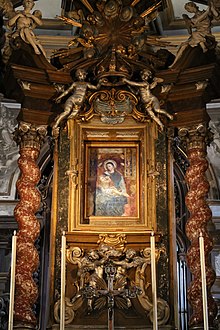
Canonical coronation

A canonical coronation (Latin: Coronatio Canonica) is a pious institutional act of the pope, duly expressed in a formal decree of a papal bull, in which the pope bestows the pontifical right to impose an ornamental crown, a diadem or an aureole to an image of Christ, Mary or Joseph that is widely venerated in a particular diocese or locality.[1][2][3][4] The act was later regulated to Marian images only, through the De coronatione imaginum B.V. Mariae that was issued on 25 March 1973.[5]

The formal act is generally carried out by a representing proxy of the pope, via the designated apostolic nuncio to a country or kingdom, or at times a lesser papal legate, or on rare occasions by the pope himself, by ceremonially attaching a crown, tiara, or stellar halo to the devotional image or statue.[6]

The Holy Office originally issued the authorisation of a canonical coronation through a dicastery, called the "Vatican Chapter". Subsequently, until 1989, the Vatican's Sacred Congregation of Rites was assigned this duty. Since then, the Congregation for Divine Worship and the Discipline of the Sacraments makes the formal consultation and arrangement to execute the ceremonial act which the decree authorizes.[7]

History
The formal act of coronation towards Marian images began with the Order of Friars Minor Capuchins, who on their evangelising missions collected great quantities of jewellery associated with the practice of indulgences, which funded at the request of the faithful, the gold crowns or accessories for images of the Blessed Virgin Mary, mainly in Italy. Although the crowning of statues and paintings occurred occasionally in antiquity and the Middle Ages, the early modern practice of the canonical coronation began with the Capuchin friar and "Apostle of the Blessed Lady", Girolamo Paolucci di Calboldi di Forlì (1552–1620), who on 27 May 1601 crowned the Madonna now enshrined at the Sanctuary of Santa Maria della Steccata in Parma, Italy.[8][9]

When the Marquis of Piacenza and Count of Borgonovo, Alessandro Sforza Cesarini died in 1636, he bequeathed in his will a large sum of money to the Vatican Chapter for the coronation of the most celebrated Marian images in the world. Funds from his bequest went towards the restoration of the Madonna della Febbre, which is now enshrined in the sacristy of Saint Peter's Basilica in Rome.[10]

Development of the rite

The enactment of the rite of the coronation of a venerated image became widely popular in the Papal States prior to 1800, when approximately 300 coronation ceremonies were performed. On 29 March 1897, an official rite titled Ordo Servandus in Tradendis Coronis Aureis Quæ Donantur a Reverendisimi Capitulo Sancti Petri de Urbe Sacris imaginibus Beatæ Mariæ Virginis was included in the Roman Pontifical, for which a plenary indulgence was also conceded to the faithful who participated in such rites.[11]

- The first Marian image ceremoniously crowned without direct papal approbation was performed by Cardinal Orazio Spinola for the Madonna of the Vineyards venerated at the Basilica of Santa Maria delle Vigne in Genoa on 5 April 1616. Pope Benedict XV later granted a decree of coronation titled Quae Civitatis Istius on 1 November 1920, signed and executed by the Archbishop of Genoa, Cardinal Tommaso Pio Boggiani in honor of the Pope's native birthplace.
- The first image of the Blessed Virgin Mary that was pontifically crowned was Lippo Memmi's painting of La Madonna della Febbre in the sacristy of Saint Peter's Basilica in Rome on 27 May 1631, by Pope Urban VIII through the Vatican Chapter.
- The first Marian image pontifically crowned outside of Rome was the Our Lady of Trsat of Croatia on 8 September 1715 by Pope Clement XI.
- The first Marian image personally crowned by a pope himself was the Madonna del Popolo on 3 June 1782 by Pope Pius VI at the Cesena Cathedral.
- The first image of Christ granted a decree of canonical coronation was granted by Pope Leo XII for the Infant Jesus of Prague on 24 September 1824. The image is now enshrined at the Carmelite Church of Our Lady of Victories in Prague, Czech Republic.
- The first image of Saint Joseph that granted a decree of canonical coronation by Pope Pius VI was for the Sanctuary of Saint Joseph in Kalisz, Poland on 15 May 1796. Pope John XXIII gifted the venerated image his personal ring, accompanied with an "epistle of consecration" in 1963. Accordingly, its paired Madonna and Child ensemble merited their own separate pontifical decrees in 1984 under the auspices of Pope John Paul II.
Enshrinement of the rite
An earlier reference to the coronation of Marian images is decreed in the 1973 apostolic brief Pluries Decursu Temporis. The solemn rite of crowning images is contained in the Ordo Coronandi Imaginem Beatae Mariae Virginis, published by the Holy Office on 25 May 1981. Prior to 1989, papal bulls authorising canonical coronations were inscribed manually on parchment. After 1989, the Congregation for Divine Worship and the Discipline of the Sacraments began issuing the authorisations, thereby authorising a papal legate to perform the coronation of the approved devotional image on behalf of the pope via an expressed decree of letters patent.

References
- ^ "Mensaje con motivo del 50 aniversario de la coronación de la imagen de la Virgen del Camino (19 de octubre de 1980) - Juan Pablo II". w2.vatican.va.
- ^ "Radiomensaje a los fieles mexicanos con ocasión del 50 aniversario de la coronación canónica de la Virgen de Guadalupe (12 de octubre de 1945) - PIUS XII". w2.vatican.va.
- ^ "CATHOLIC ENCYCLOPEDIA: Bulls and Briefs". Newadvent.org. 1 November 1908. Retrieved 6 April 2015.
- ^ "Canonical Coronation of La Virgen de la Esperanza Macarena | Hermandad de la Macarena". Hermandaddelamacarena.es. Retrieved 6 April 2015.
- ^ "De coronatione imaginum B.V. Mariae" (PDF).
- ^ "Address to members of the Vatican Chapter". Vatican.va. Retrieved 6 April 2015.
- ^ Acta Apostolicae Sedis 1973, “De Coronatione Imaginum Beatae Mariae Virginis” — PLURIES DECURSU TEMPORIS factum est ut populus christianus, filiali devotione permotus, ardenter peteret et obtineret coronationem alicuius Imaginis Beata Virgo Mariae. Nam «Maria, per gratiam Dei post Filium prae omnibus angelis et hominibus exaltata, utpote sanctissima Dei Mater, quae mysteriis Christi interfuit, speciali cultu ab Ecclesia merito honoratur.» [Congregatione Oecumenicum Vaticanum Secundum II, Constatione Dogmatis Lumen gentium, numerorum # 66.] Illius consuetudinis testimonium permanet ritus in Pontificali Romano usitatus.
- ^ Relazione della incoronazione della prodigiosa imagine della SS.ma Vergine detta Delle Grazie di Montepulciano, Ottavio Puccinelli, Rom 1742
- ^ Juan Carrero Rodríguez (2019). "11. Coronación Canónica". La Virgen de los Reyes (in Spanish). Spain: Editorial Almuzara, Colección Andalucía. ISBN 978-8418-0894-04.
- ^ Moroni, Gaetano (1842). Dizionario di erudizione storico-ecclesiastica da S. Pietro sino ai nostri …. Retrieved 6 April 2015.
- ^ Roman Ritual: Blessings, Praenotanda num. 28, Ritual coronation of an image of the Blessed Virgin Mary, nos. 10 and 14.
Further reading
- Santoro, Nicholas Joseph (2011). Mary in Our Life: Atlas of the Names and Titles of Mary, the Mother of Jesus, and Their Place in Marian Devotion. iUniverse. ISBN 978-1-4620-4022-3.
- Brie, Steve; Daggers, Jenny; Torevell, David, eds. (2009). Sacred Space: Interdisciplinary Perspectives within Contemporary Contexts. Cambridge Scholars Publishing. ISBN 978-1-4438-0642-8. See especially chapter 4, "Consumption, Sacred Places and Spaces in Profane contexts: A comparison between the UK and India" by Jan Brown, John Phillips and Vishwas Maheshwari which draws an analogy between traditional religious veneration and contemporary preoccupations with sport, shopping and film.
- de Lubac, Henri. The Eternal Feminine: a study on a text by Teilhard de Chardin. Trans. René Hague. New York: Harper & Row, 1971. See pp. 125–6. de Lubac SJ upholds the view, first promoted by Teilhard de Chardin SJ, which claims that the cult of Mary (devotion to, coronations etc.) is an essential corrective of the over-masculinisation of the Old Testament godhead in the person of Yaweh, and hence is the incarnation of the femininity of God.
See what we do next...
OR
By submitting your email or phone number, you're giving mschf permission to send you email and/or recurring marketing texts. Data rates may apply. Text stop to cancel, help for help.
Success: You're subscribed now !
